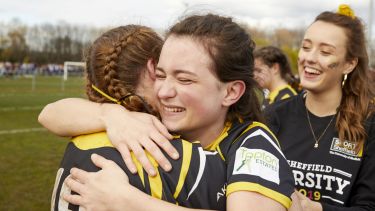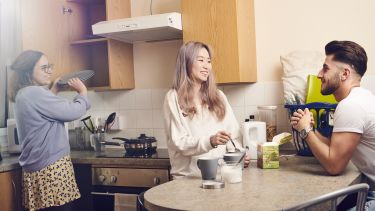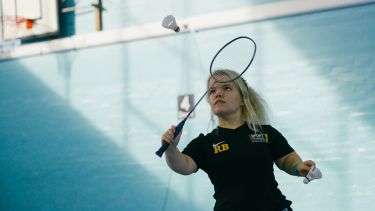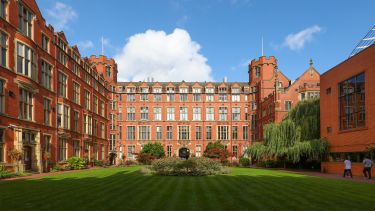Photography
We use photography to portray life at the University of Sheffield in a clear and evocative way, establishing an emotional connection with our key audiences, informing, inspiring and engaging them.
The key characteristics of our photography
Powerful deeds, confidently delivered
Our photography should portray life at the University of Sheffield in a clear and evocative way, establishing an emotional connection with our key audiences, informing, inspiring and engaging them.
It will reflect our messaging pillars as set out in the University's Communications framework (Prestige, Place, Progressive(ness) and Pride).
Sheffield photography will reflect a confident, collaborative, inclusive and inspiring tone of voice. Our photography will be user-focused, always with the audience in mind and aware of the message we are looking to convey.
Sheffield photography will feature the following characteristics:
Authenticity
Our photography will reflect the world-class nature of our university and the uniqueness of our city:
- Wherever possible, use ‘real’ people as the subjects of photography eg actual students who study the course.
- Avoid “could be anywhere” photography by incorporating Sheffield’s surroundings.
- Use natural light where possible, or light sources found within the environment. This conveys a sense of honesty.
- Wherever possible, look to ‘capture the moment’ rather than set up scenarios. Our audiences can tell when a photo has been staged.
Connection
Our imagery should form an emotional connection with our audiences, creating interest and generating excitement. Subjects should be:
- Happy (without over exaggerating)
- Engaged
- Intrigued
- In the moment
Inclusivity
Our photography should reflect and celebrate the diversity of our people. We must be conscious of achieving a broad, diverse mix of people across the breadth of our communications.
Technical characteristics
Bright light
Where possible, shoot in bright light to convey energy, happiness and optimism. Avoid dark, dimly lit locations which will convey the opposite.
High colour contrast
Where possible, use high contrast photography to convey confidence, vibrancy, and positivity.
Campaign-specific photography
The University’s reputation campaign and Fundraising and Engagement campaign utilises a more specific stylised treatment of photography.
This style is based on commissioning and identifying photographs where the subject(s) can be cut out from the background and used in isolation as part of design assets.
The cutout images are converted to monochrome with a gradient map layer added to change pure blacks to dark blue.
If you need imagery created in this style, please contact marketing@sheffield.ac.uk
Our Student Recruitment Be Sheffield Made campaign also uses a specific stylised treatment of photography.
SRMA will have a selection of approved campaign imagery, however, if you need something new or more specific, you can commission your own photography – as long as it maintains the campaign’s visual language.
Please contact the Student Recruitment Marketing team at studentrecruitmentmarketing@sheffield.ac.uk for more information.
Achieving the best images
In general, shoot images with plenty of space around the subject. Think about whether you need space to add text, if your image will include the University logo in the top left corner, if you need to allow for the fold in a double page spread etc.
During the briefing process and/or when taking the photo, think about where the image will be used to achieve the best results.
People and portraiture
For portrait photos, where possible put people in context and capture your subject in a relevant campus/city location eg chemistry student in the lab. This will create more of an interesting story and create a clearer relationship between the person and their place in the University.
Try to capture images of your subject in more than one setting, this will help to:
- Capture different aspects of the person’s experience and relationship to the University
- Show off different areas of the University
- Maximise the cost-effectiveness of the shoot and give a greater shelf-life to the images available to use
- Give you more choice – sometimes the shoot you initially had in mind won't work as planned
Group photos
Avoid extreme landscape and extreme portrait shapes when photographing groups of people. Consider the following:
- Construct a natural scene – if you need to construct a scene, try and arrange the group into a scene that feels natural. This could be as simple as them all sitting around a table having coffee together, or it could be a scene that aims to show them collaborating on a project or working together in a lab.
- Think about creative composition – most group photography involves participants being lined up in one or two vertical lines. This will always look forced, think about how you can place the group throughout the foreground, middle and background of the shot. For example, in a lab setting, it might work to have some group members further back behind a different lab bench working with others closer up.
- Sometimes you have (little to) no choice – it is important to point out that sometimes a photograph has to be taken of a group of important people together. In these situations it is advisable to try and get a variety of posed-for and candid group shots.
Action shots
These should capture people engaging with others and/or their environment. The emphasis is more often on the action rather than the person. Always keep the audience in mind and the message you’re aiming to convey. Where possible, consider the following:
- Always try to capture a natural scene rather than setting one up
- Setting up the camera ahead of a timed/planned action or event taking place
- Capturing the action from a range of angles and perspectives, eg close ups of a lab experiment as well as wider angle shots
- Avoid the person looking straight at the camera whilst the photography is taking place
Buildings and environments
These will showcase Sheffield at its best. Images could range from extreme close-ups that capture intimate details of our facilities and buildings, to wide angle shots that show the scope of our city and campus. Where suitable, people should be included in the photos. For external building shots, consider the following:
- Sunrises/sunsets
- Clear blue, bright skies
- Seasonal changes eg Firth Court with red autumn leaves or the Diamond covered in snow in winter
- Interesting angles and perspectives of your building – try to capture a range
The University Instagram feed is a great source of inspiration for the best locations on campus.
Teaching and learning
Teaching and learning shots should portray a high level of connection. We want to show our students engaged in their subjects and their peers, strong individual facial expressions or body language can help with this. When photographing large groups of students in lectures or seminars, focussing on an individual within the group can often provide a focus point and create an emotional connection.
Where possible try to:
- Capture active engagement rather than passive learning
- Capture eye contact between teacher and student
- Include relevant facilities in your photo to add more context
- Include a diverse group of people
Planning and organising your photoshoot
Asset Bank
Before you start, check the University’s Asset Bank for existing commissioned photography. As a member of staff you have access to Asset Bank automatically.
You can log on using your regular MUSE username and password: assetbank.shef.ac.uk
Choosing a photographer
We have a roster of approved photographers that can be booked to take photos. These suppliers were selected by Corporate Communications and in line with University finance regulations.
If you need advice on selecting a photographer, contact marketing@sheffield.ac.uk
Consent and data protection
See our information on data protection and download consent forms.
Template for briefing photographers
You should provide the commissioned photographer with as much relevant information as possible. You can use our briefing template (please make a copy.)
Download our photography brief template
When briefing a photographer, consider the following:
- If possible, show the photographer where the images will be used to provide context
- Where appropriate, provide the photographer with a specific list of images you wish to receive
- Make sure you photographer is briefed to shoot in the appropriate formats.
Planning your shoot
- If possible, visit the location of your photo shoot beforehand to make sure there will be no unforeseen obstacles on the day.
- Ensure any participants know where to meet and at what time. Ask them not to wear any heavily branded or messaged clothing.
- Ensure the photographer has enough time to meet the requirements of the brief.
- Schedule how you will use your time on the shoot, allowing time for the photographer to set up and people to arrive as relevant.
- Allow extra time if you need to relocate to multiple locations in one shoot.
- If you’re shooting outside, you may need to plan an alternate location or date if the weather is bad.
- Make sure you have enough data protection forms, take a few extra just in case.
During your shoot
- Recap on the brief with the photographer to make sure you achieve the desired output.
- Be aware of what’s happening in the background – does anything need to be moved? Remove anything that will date your shot – eg calendars, decorations, or materials with the year written on them.
- If your photography captures any members of the public in the shot and they are identifiable, they will also need to complete a consent form. Take a few extra forms on the shoot in case.
After your shoot
When you receive the images from the photographer, please also send the images to marketing@sheffield.ac.uk. If suitable we will add these to Asset Bank.
Alt text image descriptions
When using your images, descriptive captions and alternative text (also known as 'alt text') helps people visualise images when they can't be viewed for some reason. Your text should concisely convey the content and function of the image, not just what it is. Well-written alt text is important for accessibility reasons, and for search engine optimisation (SEO).
See also: Accessibility guidelines
Facebook, Twitter, LinkedIn and Instagram all provide specific fields for you to add alt-text for images, although alt-text for Twitter must first be enabled in the settings. You can also add alt-text through Tweetdeck or Hootsuite.
Technical specifications
Digital
Photography should be delivered as original quality, full-sized JPEGs.
The minimum size requirement for our CMS is 800 x 450 pixels. Generally, the higher the quality, the better, so use a larger image than this if you have one available.
The crops we generally work to are:
- Website - 16:9 (landscape), 1:1 (square), 8:3 (banner)
- Social - 16:9 (landscape), 9:16 (vertical), 1:1 (square)
Physical
Print and Design Solutions require images to be supplied at 300dpi at the actual size that they will be printed. This rule does not directly apply to large format printing where the artwork is done at 25% of the finished size. The image just needs to be 300dpi at the size of the artwork.
A high quality image can easily be enlarged to more than double its size without pixelating. Settings on the camera and/or saving as a JPEG should be maximum quality.
Printing is always CMYK but images can be supplied as the standard RGB and we can convert them. Images are fine to be supplied as standard JPEGs. We can convert them to TIFFs or PSDs. PNG files are fine if they are high quality and large enough.
Images should never be supplied embedded in any software such as Powerpoint, Word, Publisher or Illustrator.
Photography and video using drones
Before organising any activity using drones, you must gain permission from University Estates (EFM) and University Security. A risk assessment must be completed before drones are used on the University premises, whether indoors out outdoors.
Notify Security Management, Estates and Health & Safety Department by emailing:
flying-drones-group@sheffield.ac.uk
The full policy for use of drones is available on the Health & Safety website.
Find a health and safety policy - D
Photography on campus
- Guidance for staff managing a photoshoot is on the staff hub (login required).
- Any photographers operating on the University campus must be managed by a member of staff for a University organised photoshoot. Photographers should either be accompanied by a member of staff, or have clear written permission to work on campus.
- The University operates a check and challenge policy whereby if asked for by a member of staff, approved suppliers need to be able to show the required documentation to proceed with their work.
- Any external photographer wanting to organise a photoshoot that is not commissioned by a member of University staff would need to make a room hire booking via the Conference team for any rooms/areas they are wanting to use for taking photos. This includes photoshoots commissioned by existing students or graduates/alumni Enquiries can be made through the WithUS contact form.







